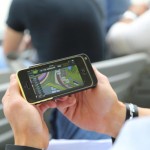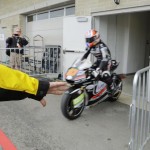There’s no such thing as being “fit” or not. We’re all “fit” in our own ways, just some are more so than others. Is 5% body fat fit? Sure, it’s been the perceived image of fitness from the beginning. Is bench pressing or squatting 400 pounds fit? Yeah, that is too. Running a sub-4 hour marathon, yep, that is too. Is a professional linebacker fit? Of course he is. A golfer? Yes. He is.
How about motorsports? Where the power of the vehicle is doing the work? Or is it? High powered bikes tightly maneuvering turns and ripping down straight aways. You better believe it.
From April 10-13 MotoGP made its stop at the Circuit of the Americas track in Austin, Texas. We had an exclusive opportunity to join the official time keepers, Tissot, over the weekend to observe the sport, the track, it’s fans, the culture, and even meet with MotoGP legend and 2006 World Champion Nicky Hayden to celebrate his 200th career race.
Seeing and feeling the high-speed breed in action
Watching MotoGP, the most premiere event in motorcycling sports, from TV is one thing. Watching MotoGP from pit lane is another; you feel the weather conditions and how they must impact the racers, you truly grasp what it must be like to maintain near-perfect riding for over 20 laps where the slightest distraction, mistake, or slip up can cost you big. Watching MotoGP from a 251-foot tower above as one rider ever so tactfully, and gracefully, slips on the inside of another and makes the crowd erupt is yet another. And finally, being on the ground, on the grid, before the main event even kicks off puts you right in their seat with them. You can feel the power of the bikes, the butterflies in their stomach, and see the stone-cold focus on their faces. “These guys are heros,” said one 14-year DORNA representative. “No matter how many races I’ve seen, it’s always amazing.”
The physical and mental demands on a rider may not be identical to those placed on a professional football player, but they definitely have them—and the risks and rewards that accompany those unique demands.
The variables working with or against racers
The weather. Think you’re hot in jeans and a t-shirt with the sun beating down on you? Imagine sitting in a skin tight suit and protective gear all while driving 100+ mph with 15 other guys chasing you lap after lap.
The bike. A MotoGP weighs approximately 330 pounds and can reach maximum speeds of 220 mph (The official fastest speed is 217.8 mph, by Marc Marquez this year). Now, imagine leaning into 20 turns for 20 laps at incredible speeds. Again, it’s one thing on TV—it’s a whole other experience to witness it in-person.
Other racers. It’s not just them, they’ve got 15+ other competitive racers right there on their tail.
The track. A couple sprinkles of rain, topography, and turns—all factors that require incredible amounts of focus.
Behind the scenes: The time keepers
You might have never thought it, but there’s 11 people working the official time of a MotoGP race. Five of them are actually recording the data that comes in and the remainder are double-checking and ensuring the accuracy. How it works: a transmitter is placed on the front of each of the bikes, the transmitter then sends and receives a signal to-and-from the bike through line that runs beneath the track. There are a number of different trigger points that send-receive the signal for better accuracy. And this technology (all powered by Tissot) continues to become more sophisticated, in fact, this is the first year that racers are now able to receive information about dangers on the track, flags, etc. It’s no longer a one way transmission from bike to time keepers.
- A nice flight.
- Gloomy sunset 1
- Gloomy sunset 2
- Gloomy sunset 3
- Came up on Pandora after the trip during writing time.
- Saturday AM arrival.
- The full track in real time. The MotoGP app for $25.
- Switched it up for minute.
- Saturday gloom clearer a bit for Sunday.
- It’s cool thinking about the size and distance.
- By accident.
- Needed to show I was happy with the view.
- Needed this thing for Nicky Hayden.
- 200 races for this man. And a 2006 world champ.
- Sticky note for the lanyard. On the ground for Moto2.
- The weekends.
- Hold traffic. Coming out.
- Very, very, very loud.
- The line.
- Now I really know what Umbrella girls do.
- Photo doesn’t do that Texas Turkey Leg Justice. Way better… and costs you 18 bucks.
- More from the grid.



























